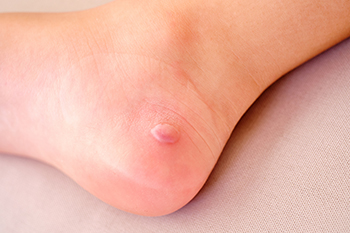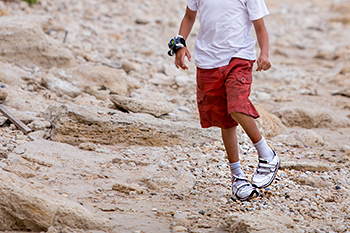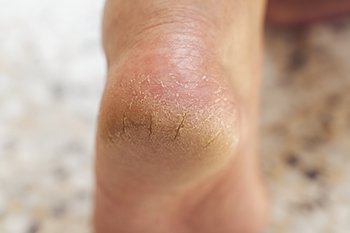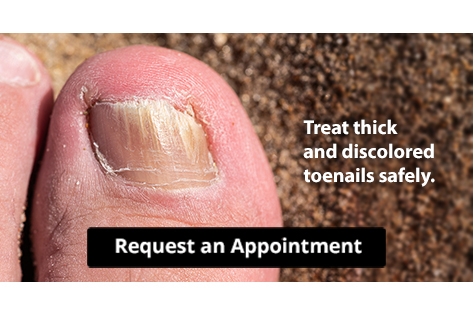Connect With Us
Blog
Items filtered by date: December 2023
Stop Your Toenail Fungus
Causes and Symptoms of Foot Blisters

Foot blisters are tiny fluid-filled sacs that form on the skin. They may seem inconspicuous but can be surprisingly uncomfortable, often arising from a combination of factors. Friction stands as a primary cause, especially when ill-fitting footwear or repetitive motion induces rubbing against the skin. Moisture and heat exacerbate the risk, as sweaty or damp conditions soften the skin, making it more prone to friction-related blisters. Additionally, poorly managed moisture, whether from excessive sweating or wet environments, creates an ideal environment for blisters. The symptoms of foot blisters include localized pain, tenderness, and a distinct swelling filled with clear fluid. The affected area may become red, and in more severe cases, the blister may rupture, leading to an open wound susceptible to infection. If you repeatedly develop foot blisters, it is suggested that you confer with a podiatrist who can offer effective relief and prevention methods.
Blisters are prone to making everyday activities extremely uncomfortable. If your feet are hurting, contact one of our doctors of Intercoastal Medical Group. Our doctors can provide the care you need to keep you pain-free and on your feet.
Foot Blisters
Foot blisters develop as a result of constantly wearing tight or ill-fitting footwear. This happens due to the constant rubbing from the shoe, which can often lead to pain.
What Are Foot Blisters?
A foot blister is a small fluid-filled pocket that forms on the upper-most layer of the skin. Blisters are filled with clear fluid and can lead to blood drainage or pus if the area becomes infected.
How Do Blisters Form?
Blisters on the feet are often the result of constant friction of skin and material, usually by shoe rubbing. Walking in sandals, boots, or shoes that don’t fit properly for long periods of time can result in a blister. Having consistent foot moisture and humidity can easily lead to blister formation.
Prevention & Treatment
It is important to properly care for the affected area in order to prevent infection and ease the pain. Do not lance the blister and use a Band-Aid to provide pain relief. Also, be sure to keep your feet dry and wear proper fitting shoes. If you see blood or pus in a blister, seek assistance from a podiatrist.
If you have any questions, please feel free to contact our offices located in Bradenton, and Sarasota, FL . We offer the newest diagnostic and treatment technologies for all your foot care needs.
Types of Foot Deformities

The intricate structure of the human foot, including bones, muscles, and tendons, is susceptible to deformities that either are present at birth or develop over time. Splayfoot, characterized by the widening of metatarsal bones, increases pressure on the forefoot, resulting in pain, calluses, and a heightened risk of developing bunions. Fallen arches, where the foot's arch is flatter than usual, can cause pain over time due to weak foot muscles, abnormal strain, unsuitable footwear, and joint inflammations. Pronated feet, marked by an inward-leaning heel, may arise in childhood, potentially causing issues later in life, particularly in overweight or knock-kneed individuals. People who have high-arched feet, may shift their weight to the ball of the foot, leading to pain, calluses, and an increased risk of ankle injuries. Equinus foot, where the foot points downward and the heel cannot touch the floor due to shortened calf muscles, presents challenges in walking and standing. Clubfoot, a severe congenital deformity involves the foot pointing downward and inward, restricting normal standing and walking. Causes of foot deformities also include abnormal strain, tight footwear, injuries, inflammations, being overweight, and underlying diseases such as osteoarthritis or rheumatoid arthritis. For assistance in managing any of these foot deformities, it is suggested that you add a podiatrist to your medical team and schedule an appointment for an exam and treatment options.
If you have any concerns about your feet, contact one of our doctors from Intercoastal Medical Group. Our doctors can provide the care you need to keep you pain-free and on your feet.
Biomechanics in Podiatry
Podiatric biomechanics is a particular sector of specialty podiatry with licensed practitioners who are trained to diagnose and treat conditions affecting the foot, ankle and lower leg. Biomechanics deals with the forces that act against the body, causing an interference with the biological structures. It focuses on the movement of the ankle, the foot and the forces that interact with them.
A History of Biomechanics
- Biomechanics dates back to the BC era in Egypt where evidence of professional foot care has been recorded.
- In 1974, biomechanics gained a higher profile from the studies of Merton Root, who claimed that by changing or controlling the forces between the ankle and the foot, corrections or conditions could be implemented to gain strength and coordination in the area.
Modern technological improvements are based on past theories and therapeutic processes that provide a better understanding of podiatric concepts for biomechanics. Computers can provide accurate information about the forces and patterns of the feet and lower legs.
Understanding biomechanics of the feet can help improve and eliminate pain, stopping further stress to the foot.
If you have any questions please feel free to contact our offices located in Bradenton, and Sarasota, FL . We offer the newest diagnostic and treatment technologies for all your foot and ankle needs.
Serious Foot and Ankle Pain

Foot and ankle pain is a common issue due to the complexity of this body region, which comprises 26 bones, 33 joints, and various soft tissues. The majority of pain in these areas is temporary, often resulting from soft tissue injuries such as sprains or strains. While these injuries typically heal gradually, some cases may take months to fully recover. However, if the pain persists, worsens, or does not improve after a few months, it may indicate more serious issues. Long-term foot or ankle pain could be caused by factors such as wearing ill-fitting footwear, osteoarthritis, inflammatory arthritis, or connective tissue diseases. Additionally, poor blood circulation or nerve damage may cause foot pain. In these instances, it is suggested that you schedule an appointment with a podiatrist for a proper diagnosis and treatment.
Foot Pain
Foot pain can be extremely painful and debilitating. If you have a foot pain, consult with one of our doctors from Intercoastal Medical Group. Our doctors will assess your condition and provide you with quality foot and ankle treatment.
Causes
Foot pain is a very broad condition that could be caused by one or more ailments. The most common include:
- Bunions
- Hammertoes
- Plantar Fasciitis
- Bone Spurs
- Corns
- Tarsal Tunnel Syndrome
- Ingrown Toenails
- Arthritis (such as Gout, Rheumatoid, and Osteoarthritis)
- Flat Feet
- Injury (from stress fractures, broken toe, foot, ankle, Achilles tendon ruptures, and sprains)
- And more
Diagnosis
To figure out the cause of foot pain, podiatrists utilize several different methods. This can range from simple visual inspections and sensation tests to X-rays and MRI scans. Prior medical history, family medical history, and any recent physical traumatic events will all be taken into consideration for a proper diagnosis.
Treatment
Treatment depends upon the cause of the foot pain. Whether it is resting, staying off the foot, or having surgery; podiatrists have a number of treatment options available for foot pain.
If you have any questions, please feel free to contact our offices located in Bradenton, and Sarasota, FL . We offer the newest diagnostic and treatment technologies for all your foot care needs.
Exploring the Causes of Cracked Heels

Cracked heels, a common foot ailment, result from a combination of environmental, lifestyle, and health factors. Insufficient moisture is a primary culprit, as dry skin lacks the flexibility to withstand the pressures of daily activities, leading to heel fissures. Prolonged standing or walking on hard surfaces can contribute to the development of cracks, especially when combined with ill-fitting shoes that fail to provide adequate support. Skin conditions such as eczema or psoriasis may exacerbate heel dryness, making them more susceptible to cracking. Unhealthy lifestyle habits, including poor nutrition and dehydration, can impact skin health, diminishing its ability to retain moisture. Obesity or excess body weight increases pressure on the heels, further predisposing them to crack. Additionally, age-related factors such as reduced oil production and diminished skin elasticity make older individuals more prone to cracked heels. If you have developed cracked heels, it is strongly suggested that you visit a podiatrist who can provide you with treatment options, which may include prescribed medication.
If the skin on your feet starts to crack, you may want to see a podiatrist to find treatment. If you have any concerns, contact one of our doctors from Intercoastal Medical Group. Our doctors can provide the care you need to keep you pain-free and on your feet.
Cracked Heels
It is important to moisturize your cracked heels in order to prevent pain, bleeding, and infection. The reason cracked heels form is because the skin on the foot is too dry to support the immense pressure placed on them. When the foot expands, the dry skin on the foot begins to split.
Ways to Help Heal Them
- Invest in a good foot cream
- Try Using Petroleum Jelly
- Ease up on Soaps
- Drink Plenty of Water
Ways to Prevent Cracked Heels
- Moisturize After Showering
- Skip a Shower
- Keep Shower Water Lukewarm
- Don’t Scrub Your Feet
If you are unsure how to proceed in treating cracked heels, seek guidance from a podiatrist. Your doctor will help you with any questions or information you may need.
If you have any questions, please feel free to contact our offices located in Bradenton, and Sarasota, FL . We offer the newest diagnostic and treatment technologies for all your foot care needs.

